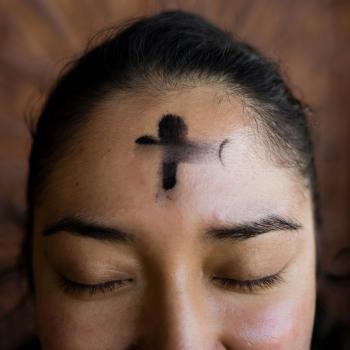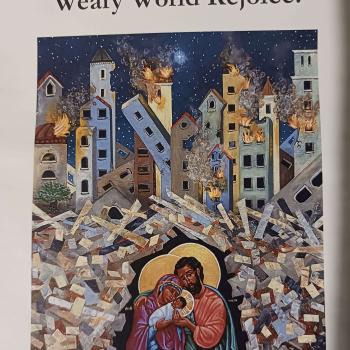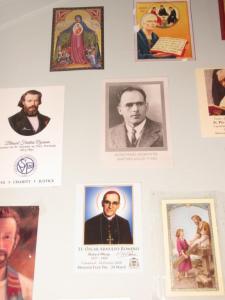Saints make the universal call to holiness unique by their own particularization of that call in their lives. They grasp an aspect of Christ’s life, putting them into communion with Christ, and in that communion, to the rest of the world. As they strive for personal holiness, their achievements help more than themselves, but everyone. No matter how isolated they might appear in the world, they are not individuals cut off from everyone else, selfishly looking only after their own affairs: they are intercessors of God’s grace to the world, making sure the work of Christ continues in history. Through them, the Church built by Christ but tarnished by human sin can be restored. While all the saints have the restoration of the Church as a part of their mission in the world, some are brought more directly into this work than others, with one of the greatest being that poor man of Assisi, St Francis.
St. Francis heard a call to restore Christ’s Church. He at first misunderstood the call to be merely the restoration of the church of St. Damian, but he would quickly find out his mission in the world extended beyond the rebuilding of one parish; it was for the rebuilding of the whole Church. How he built up St. Damian’s typifies the way he built up the Church. He worked to the full extent of his being to make sure the repair work was done. But he did more than that – he called for others to share in that work, showing that the restoration of the Church cannot be done by one person alone:
Grounded now in the humility of Christ, Francis recalled to mind the obedience enjoined upon him from the cross, to repair the church of San Damiano. As a truly obedient man, he returned to Assisi to obey the divine command at least by begging. Putting aside all embarrassment out of love of the poor Crucified, he begged from those among whom he was accustomed to have plenty, and he loaded stones upon his frail body that was weakened by fasting. With God’s help and the devoted assistance of the citizens, he completed repairs on that church.[1]
Saint Damian’s could only be rebuilt through hard work and labor combined with the resources given to St. Francis by the rich. The Church needs the cooperation of everyone within it, especially those blessed with great riches, if it is to be renewed and given what it needs to reach out and help heal the world. The Church is called to follow the example of Christ, to heal the sick and save souls: the two go together. Without resources, without Christians coming together in love for each other and the world, the sick will look elsewhere for healing and the sinner will ignore the call to holiness. St. Francis shows us that we must reach people with love, that we must love them in their personal situation, wherever they are at, for this alone leads to give us the trust needed for them to hear the message of the Gospel.
If we want the Church to be seen in its glory, we must become humble men and women of faith, following the path of St. Francis. We too must be willing to crucify ourselves in humble obedience to the Lord. While St. Francis was to uniquely represent this taking on the cross through his stigmata, we are all called to take the sign of the cross upon ourselves and to die to the self so that we can live in glory. What St. Francis wrote in his earlier rule about humility applies not just to Franciscans, but to all of us:
Therefore, let all he brothers, beware of pride and vainglory. Let us guard ourselves from the wisdom of this world and the prudence of the flesh. Because the spirit of the flesh very much strives to have the words but cares little for the activity; it does not seek a religion and holiness in an interior spirit, but wants and desires to have a religion and holiness outwardly apparent to people. They are the ones of whom the Lord says: Amen, I say to you, they have received their reward.[2]
We should live for Christ, even if it gives us no apparent response from the world. This can be quite hard; indeed, those striving for a holy way of life without support might experience the very desolation of death, the horrors of hell, in their life – but they are still called forward through all the doubt and confusion to live for Christ, and if they come through all of the suffering with faith, their work will certainly be with Christ for the redemption of the world. Though weakened in flesh, filled with sorrow because of the hardships given to them, if they persevere, they will come through their trials and tribulations with great glory. All trials lead to the strengthening of the one who holds strong to the Lord, no matter what kind of trial they faced. St Francis, as St. Bonaventure affirms, believed it was likely he was able to hold fast to Christ in part because of the opposition he faced:
As [Francis] tells, there was a woman who had a devil who spoke within her and declared that Francis was doing much harm to them, and that there were gathered against him a good five thousand [devils], planning his downfall. And the friar who heard it told it to blessed Francis: and he got up and said that perhaps he had become strong [because of it].[3]
Those who stand with Christ, loving the world and those in it, and not back down when the going gets tough will have proved themselves to be among Christ’s dearest friends. The greatness they attain will be seen in their eternal glory if not on the earth. But God, nonetheless, wants us to recognize the holy, to see the beauty of the saints, and so leads us to recognize many of his great saints in the world so as to be led by their example. Those who are not known to be saints might be greater saints than many of those whom God has made known, but those God has made known have qualities which attract attention and devotion, the kind necessary for them to lead by example. God calls forth saints in the world so they can help save the world. Those who are called to be leaders in the world are given a charism which attracts attention. Those who are not so charismatic still share in the universal work of Christ, and they still represent, in the world, the incarnation of holiness which is needed for the world’s salvation. And in doing so, they become truly themselves, even if it appears they must first deny all that they are:
In sainthood, man stops being man by making in himself a place for God: but thereby he comes truly man. The path of sainthood is the crucifixion of the natural man, the removal from oneself of the natural man, self-renunciation, as well as, at the same time, the salvation, restoration, preservation of individuality. Only a saint has true individuality, integrated by integral wisdom, and therefore he is a focus through which stream rays of grace. Sainthood is the rationally unfathomable mystery of the union of the Divine and the human, a mystery which in the God-Man was accomplished once for always in an absolute form, but which therefore can be accomplished in a man-God too by the sanctifying power of grace, by human deification. Every sacrament – and especially Holy Communion – yields such human deification, but in sainthood this union of the Divine and the human receives a stable and lasting character, so that man’s nature is changed: ‘if any man be in Christ, he is a new creature’ (2 Cor. 5:17).[4]
While holiness continues to incarnate God’s grace in the world, many, if not most of the holy will be obscure. One must be able to accept humble obscurity to be a saint of God, but this does not mean one will end up obscure. It is for God to decide. In St. Francis of Assisi, that poor man, God deigned to highlight the greatness of humility, and so he who was so poor in the world became one of the greatest in heaven. And that greatness God let shine throughout all the world so that we can share in his glory by following his example. Today, right now, we are called to rebuild Christ’s Church. Will we heed the call?
[1] (Saint) Bonaventure of Bagnoregio, “The Major Legend of Saint Francis” in Francis of Assisi: The Founder. Ed. Regis J. Armstrong, O.F.M. Cap., J.A. Wayne Hellmann, O.F.M. Conv., and William J. Short, O.F.M. (New York: New City Press, 2000), 540.
[2] St. Francis of Assisi, “The Earlier Rule,” in Francis of Assisi: The Saint. Ed. Regis J. Armstrong, O.F.M. Cap., J.A. Wayne Hellmann, O.F.M. Conv., and William J. Short, O.F.M. (New York: New City Press, 1999), 75.
[3] St. Bonaventure, Collations on the Six Days. Trans. José de Vinck (Paterson, N.J.: St. Anthony Guild Press, 1970), 278.
[4] Sergius Buglakov, “On Holy Relics” in Relics and Miracles. Trans. Boris Jakim (Grand Rapids, MI: William B. Eerdman’s Publishing Company, 2011), 19-20.











